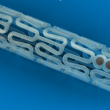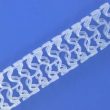Courtesy of SBHCI. According to a new quality of life sub-study, the “EXCEL”, both coronary artery bypass graft and left main PCI are associated with significant clinical improvement in terms of angina frequency, tolerance to exertion and treatment satisfaction. At 12 and 36 months, there were no significant differences between PCI and surgery after several quality of<a href="https://solaci.org/en/2017/11/01/excel-qol-substudy-similar-quality-of-life-both-with-cabg-and-left-main-pci/" title="Read more" >...</a>
DARE: Drug-Coated Balloons Compete with DES for the Treatment of In-Stent Restenosis
Courtesy of the Brazilian Society of Hemodynamics and Interventional Cardiology (SBHCI). The SeQuent Please paclitaxel-coated balloon provides non-inferior angiographic results when compared with the Xience everolimus-eluting stent for the treatment of in-stent restenosis. At 6 months, the minimal lumen diameter was 1.71 mm in the drug-coated balloon arm and 1.74 mm in the Xience arm, a difference that<a href="https://solaci.org/en/2017/11/01/dare-drug-coated-balloons-compete-with-des-for-the-treatment-of-in-stent-restenosis/" title="Read more" >...</a>
2.0-mm DES for Very Small Vessels: Are They Viable?
The reference vessel diameter is a fundamental factor for restenosis after coronary angioplasty even with drug-eluting stents. The smallest sized stents available are 2.25 mm in diameter, but even smaller vessels can be symptomatic. This was a prospective multicenter trial of the Resolute Onyx 2.0-mm zotarolimus-eluting stent. The primary endpoint was target lesion failure. Read also: “Effects<a href="https://solaci.org/en/2017/10/25/2-0-mm-des-for-very-small-vessels-are-they-viable/" title="Read more" >...</a>
Excellent Outcomes for the First Sirolimus Eluting Balloon Tested on Instent Restesosis
Much has been done since studies on conventional balloon angioplasty for BMS instent restenosis showed over 40% new revascularization. Drug eluting stents, aimed at improving this problem, have never achieved 0% restenosis, which is why technologies such as paclitaxel coated balloons have been developed, with reasonable efficacy (8% to 10% reinterventions rate for BMS restenosis and 17% to 23%<a href="https://solaci.org/en/2017/10/20/excellent-outcomes-for-the-first-sirolimus-eluting-balloon-tested-on-instent-restesosis/" title="Read more" >...</a>
Bioresorbable Scaffolds Must Not Be Chosen Over Current DES
Although there are 4 approved bioresorbable scaffolds (BRS) in Europe, experts suggest that current drug-eluting stents (DES) are the best option for coronary angioplasty. These new guidelines jointly published by the European Society of Cardiology (ESC) and the Association of Percutaneous Cardiovascular Interventions (EAPCI) are an update on the use of BRS in clinical practice<a href="https://solaci.org/en/2017/10/19/bioresorbable-scaffolds-must-not-be-chosen-over-current-des/" title="Read more" >...</a>
Impella Improves Safety in High Risk Unprotected Left Main PCI
Courtesy of Dr. Carlos Fava. The incidence of unprotected left main severe stenosis ranges between 4 and 8%, and it’s mostly associated with multivessel disease. The use of left ventricular support devices in high risk unprotected left main PCI is on the rise, but not much information available in this regard. Read also: “Prior assistance<a href="https://solaci.org/en/2017/10/18/impella-improves-safety-in-high-risk-unprotected-left-main-pci/" title="Read more" >...</a>
Early Coronary Angiography in High-Risk Non-ST-Elevation ACS
Coronary angiography is essential for patients admitted with non-ST-elevation acute coronary syndrome, since it allows physicians to confirm the diagnosis, stratify the risk, and define the revascularization and antithrombotic management strategies. There is no doubt that these patients should be studied invasively, but the timing for that is still uncertain. Coronary catheterization within<a href="https://solaci.org/en/2017/10/09/early-coronary-angiography-in-high-risk-non-st-elevation-acs/" title="Read more" >...</a>
With Absorb Out, New Resorbable Scaffolds Have Come onto the Market
By restoring vascular physiology and eliminating the inflammatory focus and the chance of fracture and neo atherosclerosis inherent to DES, bioresorbable scaffolds offer the potential to improve long term outcomes. A number of bioresorbable materials have been tested, mainly polylactic acid, with several limitations that have taken the Absorb bioresorbable scaffold out of the market.<a href="https://solaci.org/en/2017/10/09/with-absorb-out-new-resorbable-scaffolds-have-come-onto-the-market/" title="Read more" >...</a>
Frequency and Evolution of Cardiac Perforation in Patients with a History of MRS
Courtesy of Dr. Carlos Fava. Coronary perforation (CP) is a very uncommon event (≈0.4%), associated with severe complications that entail risk of death. It has usually been related to patients with a history of myocardial revascularization surgery (MRS). However, this group usually presents lower rates of cardiac tamponade due to pericardial fibrosis caused by surgery. This<a href="https://solaci.org/en/2017/10/05/frequency-and-evolution-of-cardiac-perforation-in-patients-with-a-history-of-mrs/" title="Read more" >...</a>
These Are the Thrombosis Predictors for Absorb Bioresorbable Scaffolds
J Am Coll Cardiol Intv has recently published a special issue on bioresorbable scaffolds. Abbott’s decision to pull Absorb off the market probably prompted the fast publishing of all related articles sent to the journal. Bioresorbable scaffolds were developed in hopes that they would reduce the rates of events per year 1 year post-implantation by 1.5%-3%<a href="https://solaci.org/en/2017/09/28/these-are-the-thrombosis-predictors-for-absorb-bioresorbable-scaffolds/" title="Read more" >...</a>









